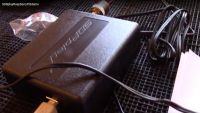SDR receiver for Raspberry Pi
Most computer platforms have the ability to connect sensors that operate in the audio band (microphones) or in the visible light (e.g. cameras). However, sensors for electromagnetic radiation in the radio range are not popular and until recently it was difficult to connect to computers systems allowing for any collection of radio waves.
In terms of radio waves, we can find both radio and television broadcasting programs for the public, as well as various types of communication systems - digital and analog. In the times of Internet surveillance, radio communication is becoming more and more irreplaceable, especially as it does not require complicated equipment to implement it.
At the same time, more and more sensors and input devices for our computers are produced. If you are interested in collecting and analyzing radio waves, it is possible and quite simple. All you need is a simple receiver and SDR system.
SDR is the so-called "software-defined radio", i.e. a radio in which the internal structure of the radio - bandwidth, modulation method, etc. - is programmed. Thanks to this, AM and FM radios for different frequency bands can be integrated in one device. These types of SDR systems come in many forms, many of which can be connected to a computer, such as a Raspberry Pi, to turn it into a radio receiver.
The family of SDRplay compatible chipsets is popular among radio amateurs. These systems allow the creation of receivers operating in the range from 1 kHz to 2 GHz, which would have cost several thousand dollars a dozen or so years ago.
SDRPlay is available for download on the Raspberry Pi 3 module's SD card and has full Linux support for this computer. Many open source SDR packages such as SoapySDR and Cubic SDR were used to create this software.
Regardless of the application, be it radio astronomy, meteorology, research (or maybe eavesdropping) of communication systems or the development of the Internet of Things infrastructure, the SDR system based on the Raspberry Pi can be very useful.
The video below presents the possibilities of the described software for the popular 'Raspberry'.
Source: https://www.rs-online.com/designspark/high-pe...y-pi-3?cm_mmc=PL-EM-_-DSN_20170703-_-DM66145- _-BOX2_URL1 & cid = DM66145 & bid = 343268483
In terms of radio waves, we can find both radio and television broadcasting programs for the public, as well as various types of communication systems - digital and analog. In the times of Internet surveillance, radio communication is becoming more and more irreplaceable, especially as it does not require complicated equipment to implement it.
At the same time, more and more sensors and input devices for our computers are produced. If you are interested in collecting and analyzing radio waves, it is possible and quite simple. All you need is a simple receiver and SDR system.
SDR is the so-called "software-defined radio", i.e. a radio in which the internal structure of the radio - bandwidth, modulation method, etc. - is programmed. Thanks to this, AM and FM radios for different frequency bands can be integrated in one device. These types of SDR systems come in many forms, many of which can be connected to a computer, such as a Raspberry Pi, to turn it into a radio receiver.
The family of SDRplay compatible chipsets is popular among radio amateurs. These systems allow the creation of receivers operating in the range from 1 kHz to 2 GHz, which would have cost several thousand dollars a dozen or so years ago.
SDRPlay is available for download on the Raspberry Pi 3 module's SD card and has full Linux support for this computer. Many open source SDR packages such as SoapySDR and Cubic SDR were used to create this software.
Regardless of the application, be it radio astronomy, meteorology, research (or maybe eavesdropping) of communication systems or the development of the Internet of Things infrastructure, the SDR system based on the Raspberry Pi can be very useful.
The video below presents the possibilities of the described software for the popular 'Raspberry'.
Source: https://www.rs-online.com/designspark/high-pe...y-pi-3?cm_mmc=PL-EM-_-DSN_20170703-_-DM66145- _-BOX2_URL1 & cid = DM66145 & bid = 343268483





Comments
There are a lot of articles on how to connect an SDR receiver to a Raspberry. Just type in the search engine, for example "raspberry pi sdr". However, the one described above is very general. The video... [Read more]
But what a fun that you can receive and decode e.g. a meteo fax ... [Read more]
If you didn't notice my friend, this is DIY Abroad - translation of the article to which you have the link provided. In my opinion it is not outdated at all - it gives a lot of satisfaction and great... [Read more]
I did not mean that the use of SDR is outdated, but the "novelty" of the article. Sometimes I use SDR for various purposes myself. Only that the topic is known for a long time and much better described... [Read more]
then provide these links and the thread will be richer. [Read more]
After all, we have quite a large thread about SDR RTL http://www.elektroda.pl/rtvforum/topic2353101-1140.html#16598220 [Read more]
There is no substitute for conventional radio. Anything Baofeng has several times greater sensitivity and dynamics than RTL [Read more]
SDR is not the same as RTL. There are SDRs that conventional radios, better than Baofeng, cannot match in terms of parameters. [Read more]